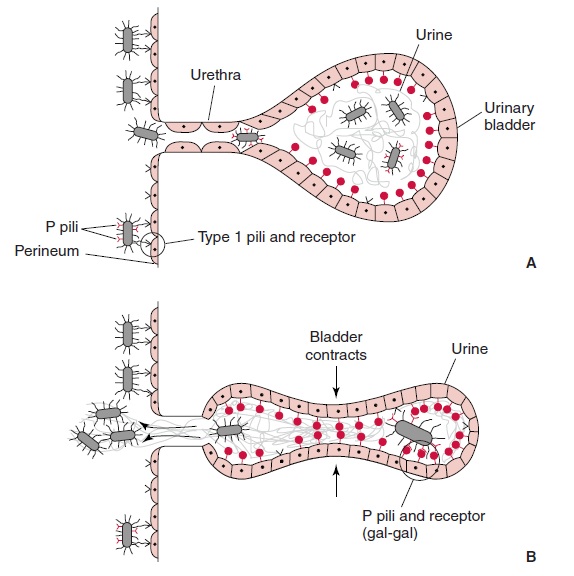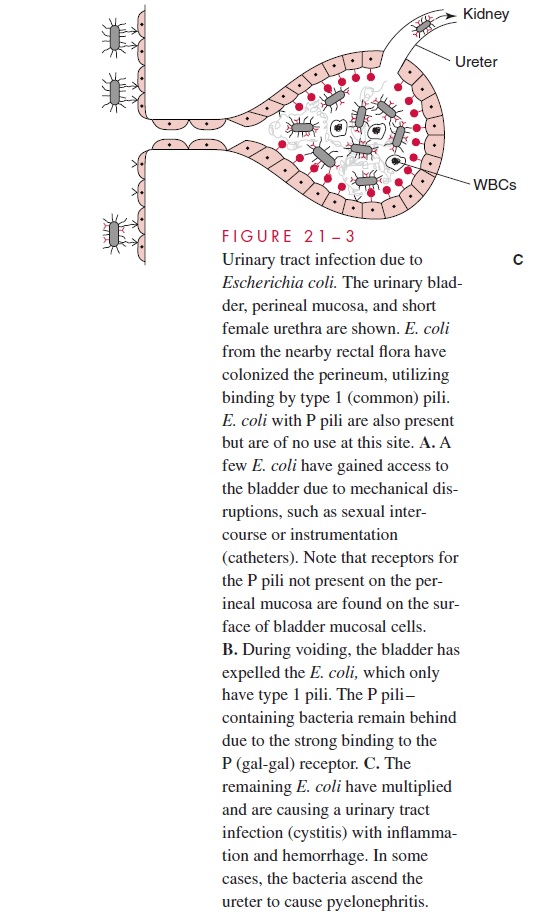Chapter: Medical Microbiology: An Introduction to Infectious Diseases: Enterobacteriaceae
Escherichia Coli Opportunistic Infections
E .colI OPPORTUNISTIC INFECTIONS
URINARY TRACT INFECTION (UTI)
The term UTI encompasses a range of infections from simple cystitis involving the bladder to full-blown infection of the entire urinary tract, including the renal pelvis and kidney (pyelonephritis). The primary feature of cystitis is frequent uri-nation, which has a painful burning quality. In pyelonephritis, symptoms include fever, general malaise, and flank pain in addition to the frequent urination. Cystitis is usually self-limiting, but infection of the upper urinary tract carries a risk of spread to the bloodstream. It is the leading cause of Gram-negative sepsis and sep-tic shock.
Epidemiology
E. coli accounts for more than 90% of the more than 7 million cases of cystitis and250,000 of pyelonephritis estimated to occur in otherwise healthy individuals every year in the United States. UTIs are more common in women, 40% of whom have an episode in their lifetime, usually when they are sexually active. The reservoir for these infections is the patient’s own intestinal E. coli flora, which contaminate the perineal and urethral area. In individuals with urinary tract obstruction or instrumentation, environment sources as-sume some importance.
Pathogenesis
Relatively minor trauma or the mechanical effect of sexual intercourse have been shown to allow bacteria access to the bladder. In most instances, these bacteria are purged by the flushing action of voiding. Factors that violate bladder integrity (urinary catheters) or that obstruct urine outflow (enlarged prostate) are also associated with in-fection. However, this cannot be the whole story; fewer than 10 E. coli serotypes ac-count for the majority of UTI cases, and these UTI serotypes are not the dominant ones in the fecal flora.
The ability of uropathic E. coli (UPEC) to produce UTI is related to general virulence factors such as -hemolysin, together with pili-mediated adherence to uroepithelial cells. The percentage of E. coli with P pili increases from 20% in the fecal flora to 70% in pyelonephritis isolates. Asymptomatic bacteriuria and cystitis isolates fall in between. The digalactoside receptor for P is present on uroepithelial cells, to which the bacteria bind avidly, particularly in the upper urinary tract. By aiding in periurethral colonization as the prelude to bladder access, type 1 pili are important as well. In addition, type 1 pili are essential for attachment to urinary epithelium in the urinary bladder where they ap-pear to keep their invertible segment in the “on” position. They are not involved in pyelonephritis where P pili are more important. Antipilin antibody blocks adherence in experimental systems, suggesting that immunization could be an approach to UTI preven-tion. The pathogenic features that allow E. coli to play such a prominent role in this dis-ease are illustrated in Figure 21 – 3.


OTHER OPPORTUNISTIC INFECTIONS
Meningitis
E. coli is one of the most common causes of neonatal meningitis, many features of whichare similar to group B streptococcal disease . The pathogenesis involves vaginal E. coli colonization of the infant via ruptured amniotic membranes or during childbirth. Failure of protective maternal immunoglobulin M (IgM) antibodies to cross the placenta and the special susceptibility of newborns surely plays a role. Fully 75% of cases are caused by strains possessing the K1 capsular polysaccharide that contains sialic acid and is structurally identical to the group B polysaccharide of Neisseria meningitidis, another cause of meningitis. There is some evidence that these strains have a type of pili with the property of adherence to brain microvascular endothelial cells.
With the exception of UTIs, extraintestinal E. coli infections are uncommon unless there is a significant breach in host defenses. Opportunistic infection may follow mechan-ical damage such as a ruptured intestinal diverticulum, trauma, or involve a generalized impairment of immune function. The virulence factors involved are likely the same as with UTI (eg, pili, -hemolysin) but have been less specifically studied. Failure of local control of infection can lead to spread and eventually Gram-negative septic shock. A sig-nificant proportion of blood isolates have the K1 surface polysaccharide. The particular diseases that result depend on the sites involved and include many of the syndromes.
Related Topics